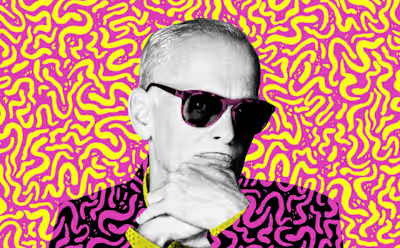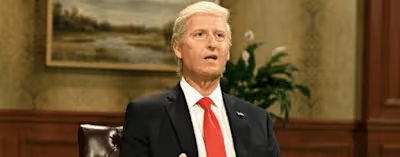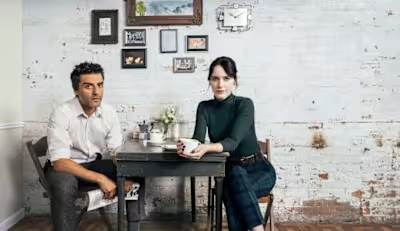In Blue Beetle, Xolo Maridueña and Ángel Manuel Soto Tell a Mag…
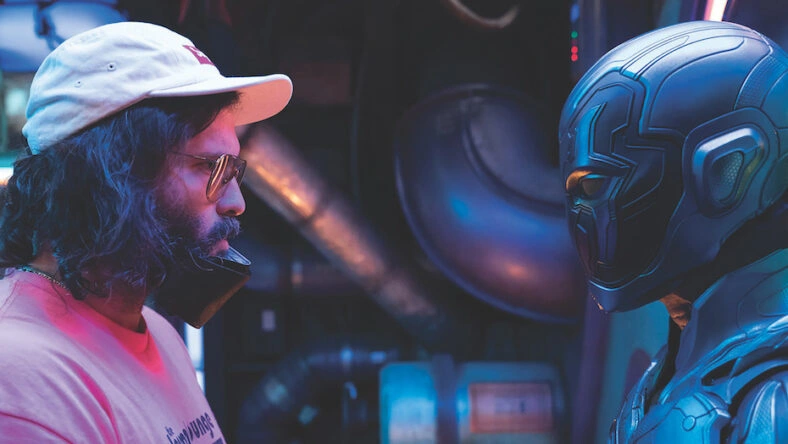
In Blue Beetle, Xolo Mariduena and Angel Manuel Soto Tell a Magical Realist Superhero Story
Blue Beetle — a big-budget superhero movie that just may point the way forward for the whole DC Universe — owes its existence in part to the Sundance Film Festival.
The film’s director, Ángel Manuel Soto, met its star, Xolo Maridueña, at a party thrown at the prestigious Park City event in January of 2020. Soto was there with his first studio film, the Baltimore dirt-bike epic Charm City Kings, which won the U.S. Dramatic Special Jury Award for Ensemble Cast.
Soto had no idea at first that Maridueña was “the kid from Cobra Kai,” even though they met over a dinner planned by one of the Karate Kid offshoot’s producers. Cobra Kai, which aired on YouTube Red/Premium for its first two seasons, was about to move to Netflix, where it would become a massive, heartfelt hit. Maridueña holds its emotional center as Miguel Diaz, a new kid in town who, like Ralph Macchio’s Daniel LaRusso in the original Karate Kid, finds his way with help from an older mentor in martial arts.
Maridueña struck Soto as humble, easy to talk to, and very honest.

Xolo Maridueña on the latest cover of MovieMaker Magazine, on newstands now. Photo by Hopper Stone/SMPSP. Cover design by Ryan Ward.
“Xolo’s very smart. He’s not aloof or anything like that. He’s a very smart kid. He’s eloquent, but he’s also a kid that lives in his age,” says Soto. “He can be funny and quirky and then he gets self-aware that he’s quirky and then he gets serious again.”
When Warner Bros. asked Soto to direct Blue Beetle based in part on his success with Charm City Kings, he began reading some of the superhero’s biggest stories. The “Blue Beetle” concept goes back to 1939, when Blue Beetle was a staple of the now-defunct Fox Comics and starred in his own radio serial. The character soon became the property of DC Comics, which in 2007 introduced a teenage version named Jaime Reyes — the third Blue Beetle. Soto remembers thinking as he read Reyes’ adventures: “Oh my gosh, he looks so much like Xolo.”
They acted alike too — everything from the way Jaime Reyes talked, to his relationship with his family. “I was like, ‘Holy s—, this is Xolo,’” Soto says. “It almost feels like the comic is inspired by him. Even his personality and the charisma and the honesty, the innocence, all that stuff that plays into the character of Jaime Reyes, Xolo embodies it.”
“I think Ángel saw things in me that even I didn’t see,” says Maridueña. “Jaime’s bestowed with this larger-than-life opportunity that he doesn’t feel fit for, and in many ways. I felt parallels between our experiences.”
The director offered the actor the part over dinner, asking him, “Do you want to be the first Latino superhero?”
Maridueña started crying, and called his mom. “It was such a beautiful moment,” Soto says.
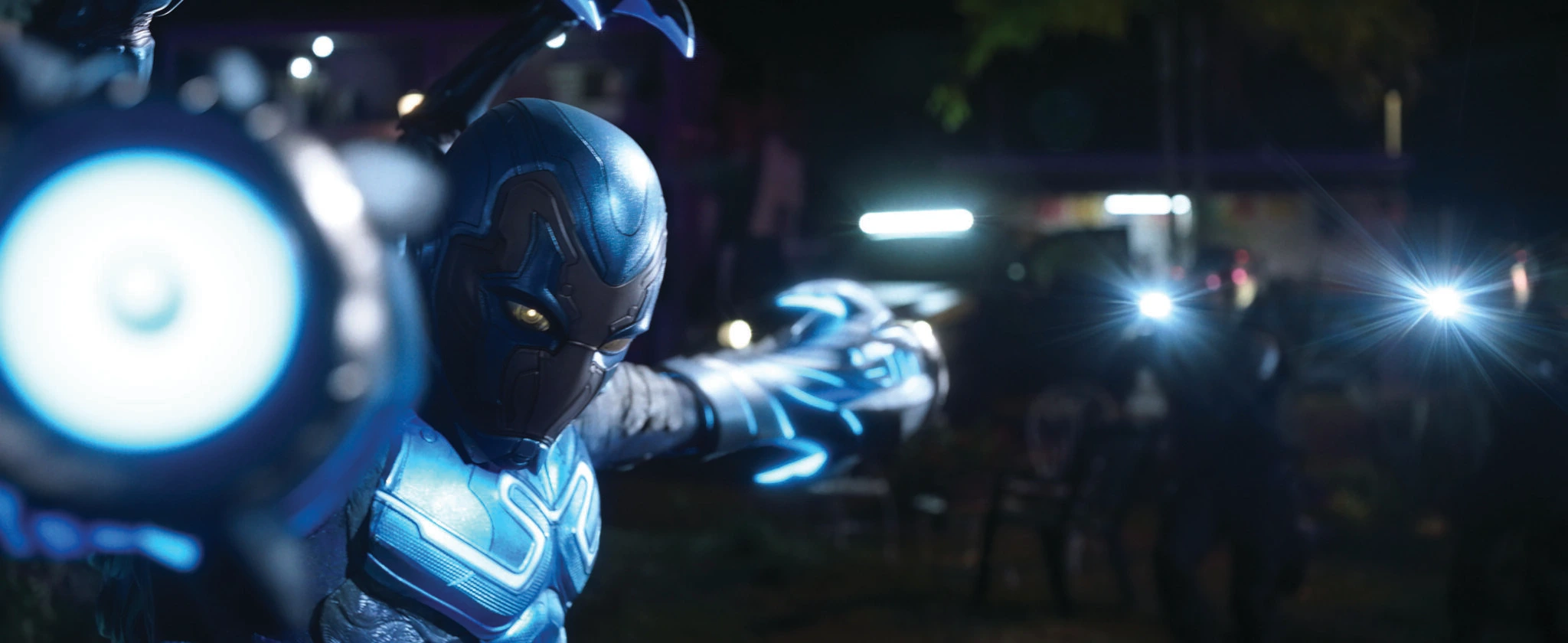
Blue Beetle Is the First Standalone Story of the New DCU
Blue Beetle, which is now in theaters, was in the works at Warner Bros. years before James Gunn came aboard to launch the new DCU. The director of Marvel’s Guardians of the Galaxy franchise was temporarily fired from it over old tweets he has repeatedly apologized for — he told MovieMaker that he used the occasion to make changes and think about his true values.
But soon enough, DC hired him to direct 2021’s The Suicide Squad, Marvel rehired him to direct the May release Guardians of the Galaxy Vol. 3, and, between the two films, Warner Bros. brought him in as the new co-CEO of DC Studios with Peter Safran.
The two are overseeing a complete revamp of the universe that includes Superman, Batman, Wonder Woman and other iconic heroes. The Flash, released in June and also in the works long before Gunn and Safran took over, was the first DC film released on their watch, and incorporated decades of past DC lore.
But in some ways, Blue Beetle is the future: It is the first standalone story of the new DC era.
Soto built his career on finding the brilliance in others. At 19, he studied architecture and advertising because there wasn’t a film school in Puerto Rico, where he was born and raised. He carved out a career for himself making documentaries and features, and became known for immersing himself in his subjects, hoping to bring the best representation of his research to the screen. His first feature film, La Granja (The Farm), was a low-budget indie shot entirely on handheld cameras that followed a boxer, a midwife and a kid with a bike as they reckoned with economic collapse in Puerto Rico.
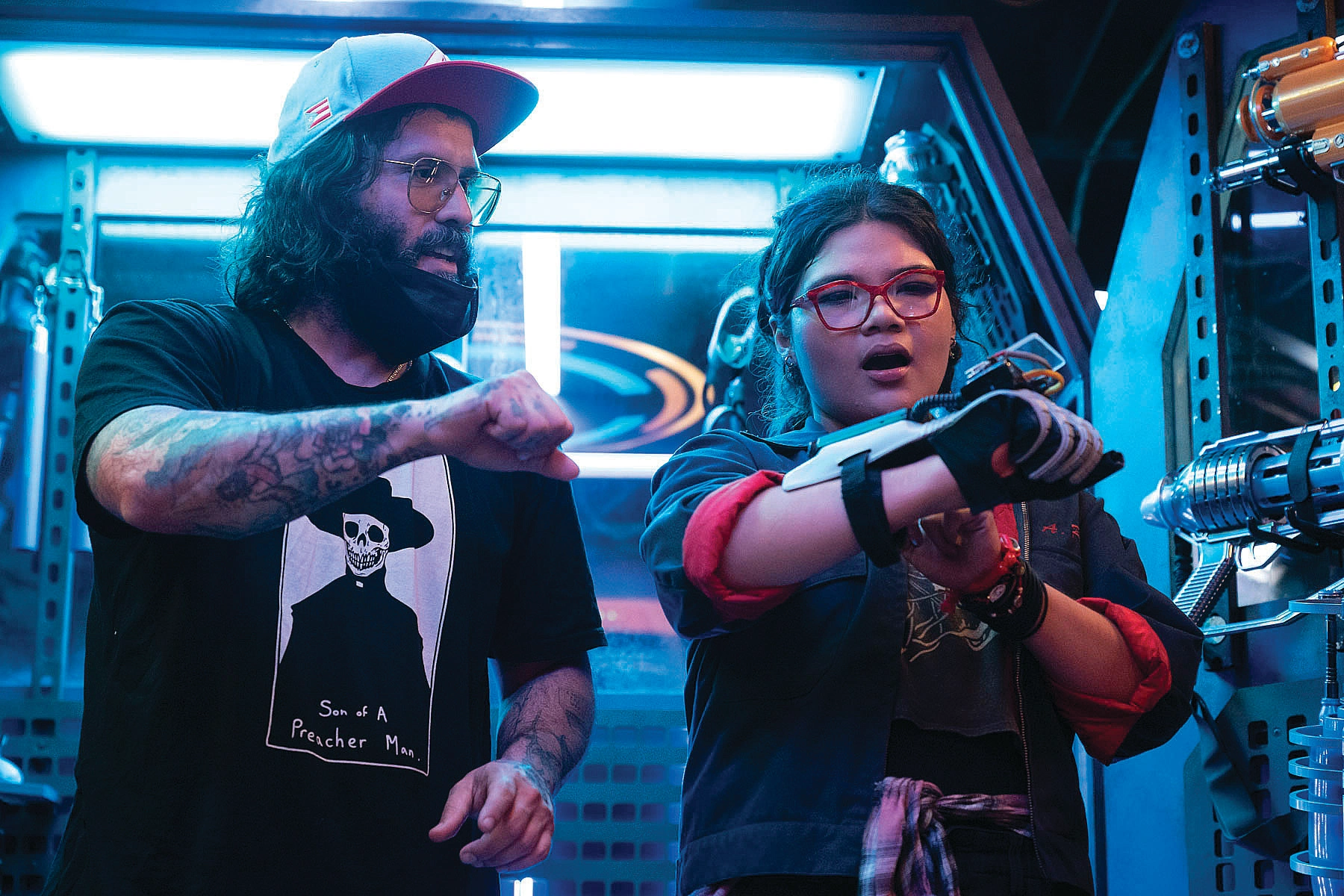
Blue Beetle director Ángel Manuel Soto and star Belissa Escobedo on set. Photo by Hopper Stone/SMPSP.
For Charm City Kings, which was released on Warner’s HBO Max in 2020, Soto spent seven weeks in Baltimore before shooting — and learned about the city from locals. “I didn’t want them to feel like I was there to paint my version of Baltimore,” he told MovieMaker in 2020.
“On the contrary, I wanted them to tell me how they felt about how we were doing it. … I wanted to respect the city as much as possible in the same way that I wish others respected Puerto Rico in their depictions of it.”
Those experiences helped him hone his instinct to act on his hunches, like hiring Maridueña. Blue Beetle is his first leading role in a movie.
The 22-year-old actor, who is from Los Angeles and is of Cuban, Mexican and Ecuadorian descent, got his start as a child model before learning the entertainment business on the NBC dramedy Parenthood. In 2013, he had a small part in the movie Dealin’ with Idiots, and other roles have included parts on TNT’s Major Crimes and Showtime’s Twin Peaks.
But Cobra Kai presented a wider range of his talents.
Over the show’s five seasons, Miguel Diaz has been a lonely outcast, a popular martial artist, a near-son to William Zabka’s Johnny Lawrence, and a romantic lead.
He has fought valiantly — with Maridueña doing most of his own stunts — in dojos, school hallways, a school cafeteria, a living room, in backyards, in an apartment courtyard, in tournaments. He has endured an injury that put him in a wheelchair, and struggled back to fighting again. Maridueña makes him eminently relatable, and inspiringly heroic.
Along the way, Maridueña gained a best friend in co-star Jacob Bertrand (who plays Hawk on Cobra Kai), with whom he hosts the freewheeling podcast Lone Lobos, about two guys just figuring out life. In the first episode, two years ago, they discussed posthumous hip-hop releases and Bertrand, who had recently turned 21, comedically recounted his first visit to a brewery.

If Gunn’s Guardians of the Galaxy Vol. 3 is about the love of chosen families, and The Flash is about longing for your birth family, then Blue Beetle is about the fight to protect your family.
As the first superhero film with a Latino family at its center, it stands both as a fun summer popcorn movie, and as a parable about the immigrant experience in the United States.
While Blue Beetle is hardly short on action, it’s grounded in everyday issues like paying the bills and the roles people play within their families. The movie opens with Jamie fresh out of Gotham Law with a pre-law degree. He can’t find a good job, and moves home to his family’s house in fictional Palmera City, which is inspired in part by El Paso, Texas, Jaime’s hometown in the comics.
Jaime soon comes into conflict with the duplicitous Victoria Kord (Susan Sarandon), head of Kord Industries. She tries to harness a piece of alien technology called a scarab, but it escapes from her clutches and turns Jamie into the Blue Beetle.
Strikingly — in a genre dominated by endless, hyperbolic raising of the stakes — Blue Beetle doesn’t save the planet. The movie is more concerned with the ways our families save us when we’re in need.
“We want to invite people into Jaime’s experience, into the Reyes’ family home and their environment,” says Soto.

(L-R): Elipidia Carrillo as Rocio, George Lopez as Uncle Rudy, Xolo Mar as Jaime Reyes, Belissa Escobedo as Milagro and Damian Alcanzar as Alberto in Blue Beetle, a Warner Bros. Pictures Release. Photo by Hopper Stone/SMPSP/™ & © DC Comics.
Maridueña thinks one of the most important and exciting things about Blue Beetle is that “we aren’t dealing with an alien invasion that’s going to take over the whole world, or a monster that’s going to destroy the city. … This is a movie about issues that not only Jaime faces, but the whole Reyes family, and greater Palmera City. All of us can relate to their struggle.”
Jaime Reyes is optimistic and a hard worker. He’s dotted every i and crossed every t, but somehow, he’s drawn the short end of the stick since leaving Gotham. The entire Reyes family is really an archetype of the American Dream gone awry.
The film’s themes aren’t heavy-handed or politically coded. But at its most human level, the family’s story is about something that’s on almost everyone’s minds these days: economic insecurity.
“That was something that I really connected with as someone who is constantly having to work a little bit harder for the same thing as some of my acting counterparts,” says Maridueña. “Exploring this family that really deserves more was such a pleasure. Hopefully we highlight some real issues people face.”
Soto felt the magnitude of presenting the first big-budget superhero story with a Latino protagonist.
“I did not take that lightly, as far as what it meant, not just to fans of the beloved character, but also to the culture,” he says.
Soto handled the weight of expectation as he always does: “I like to do a lot of research. I like to dive into world building as much as I can.”
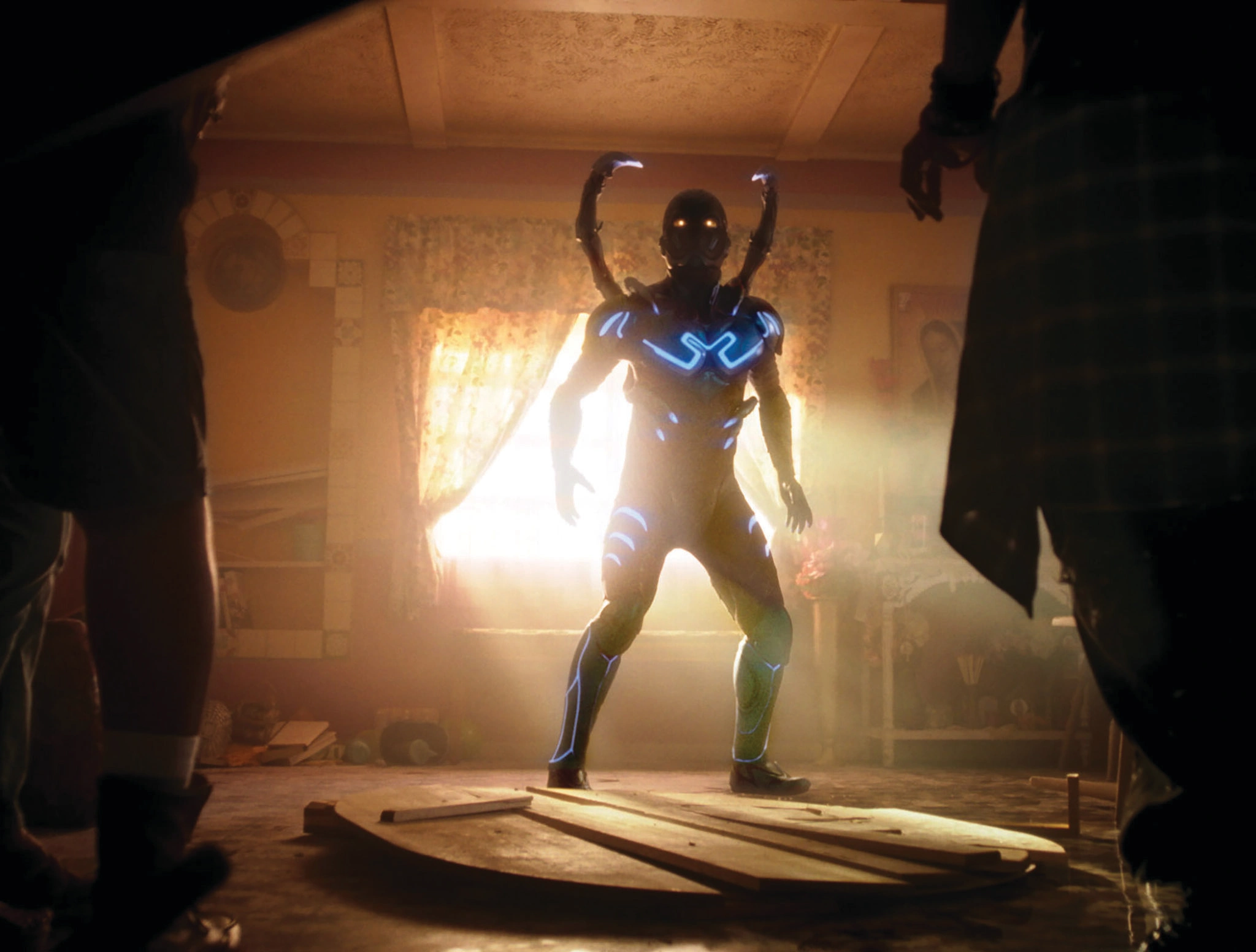
Soto’s team spent time with artists in El Paso and people from the city’s historic Latin neighborhood El Segundo Barrioto accurately depict life there.
“I started doing this type of immersion on my first film La Granja (The Farm). It’s about creating an authentic experience on screen,” Soto says.
Jaime’s extraordinary connection to his family, community, and city couldn’t be ignored, and El Segundo Barrio imprinted itself on the filmmaker and his movie.
“While the Reyes’ family-first culture might be foreign to some, the idea ultimately is to invite viewers in,” says Soto.
Belissa Escobedo, who plays Jamie’s sister, Milagro, said something that stuck with the director: “We’ve always known we’re superheroes, but now the world has an opportunity to see us as superheroes.”
Maridueña appreciates that Blue Beetle is a joyful Latino family story.
“I don’t want to throw shade because that’s not my point at all. But a lot of Latino stories are rooted in trauma or how hard it is to be a Latino,” he says. “I love that the Reyes family is proud, and although yeah, they struggle and go through hardships, it’s always something that they can overcome — and they never ask for pity.”
He adds, “Everyone deserves to have these happy stories and that’s something that I hope more movies in the future will be able to naturally incorporate.”
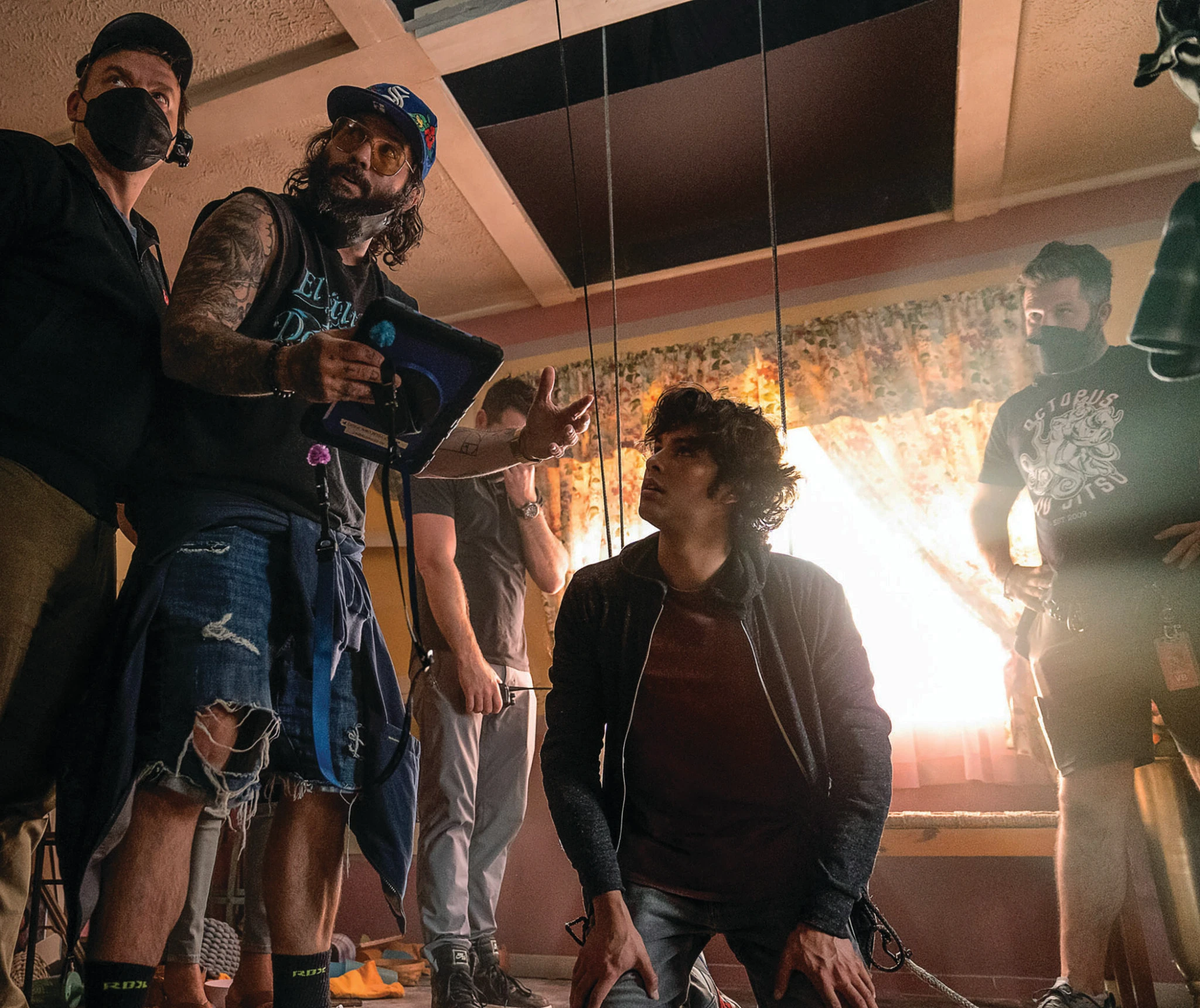
Blue Beetle director Ángel Manuel Soto and star Xolo Maridueña on set. Photo by Hopper Stone/SMPSP
Blue Beetle Parallels With Real Life
Although Blue Beetle is a happy story, it’s not without tragedy and sacrifice.
In addition to Escobedo as Milagro, Jaime’s family includes Elpidia Carrillo as Jaime’s mother Rocio, Adriana Barraza as his Nana, Damián Alcázar as his father Alberto, and George Lopez as his Uncle Rudy, who is based on writer Gareth Dunnet-Alcocer’s uncle. Before the movie begins, the family has immigrated to America from Mexico, but Alberto doesn’t have documentation, so he’s under the constant threat of deportation.
It might have sunk Jeb Bush’s 2016 presidential campaign to say illegal immigration to the United States is an “act of love,” but Alberto proves that it is.
Though the film doesn’t depict an ICE raid, it does include a scene that echoes one. Kord Industries invades the family’s home in a scene that can play as just another dramatic moment in a superhero movie – or be taken as symbolic of events that tear apart real families.
Soto embraced the parallels.
“There is a history that exists before an ICE raid. A history that includes traveling miles, and danger, working hard, becoming a family, creating memories, and thinking that everything is going to be okay,” says Soto. “But all of a sudden, everything that you have fought for, everything that you have worked for, everything that you have built, is now burning.
“I needed the depiction to be triggering, because it’s the experience of many.”
The experience with Kord Industries marks a turning point for Jaime, who vows to protect his family.
“Love is a heroic act, in its own way,” says Soto.
“I love that I saw myself in all of the characters, but it’s also what my family feels like,” says Maridueña. “I think that really is a testament of Gareth Dunnet-Alcocer‘s writing.”
Dunnet-Alcocer broke out with his 2014 short, “Contrapelo,” about a barber who is forced to cut the beard of a drug cartel leader — or risk everything by taking his life. It played at film festivals all over the world. Next, he’s writing El Muerto, starring music superstar Bad Bunny as a Luchador from the Spider-Man comics who gains special powers from a mystical mask.
Soto wanted the Reyes family to be central to Blue Beetle “because every drop of that family fills the cup inside of our hero.”
“Without having superpowers, the family goes to every length to protect their kid,” says Soto. “The love of Jaime’s family helps him finish his journey and his arc.”
“Really, it is the love that you have for your family that trumps all,” adds Maridueña.
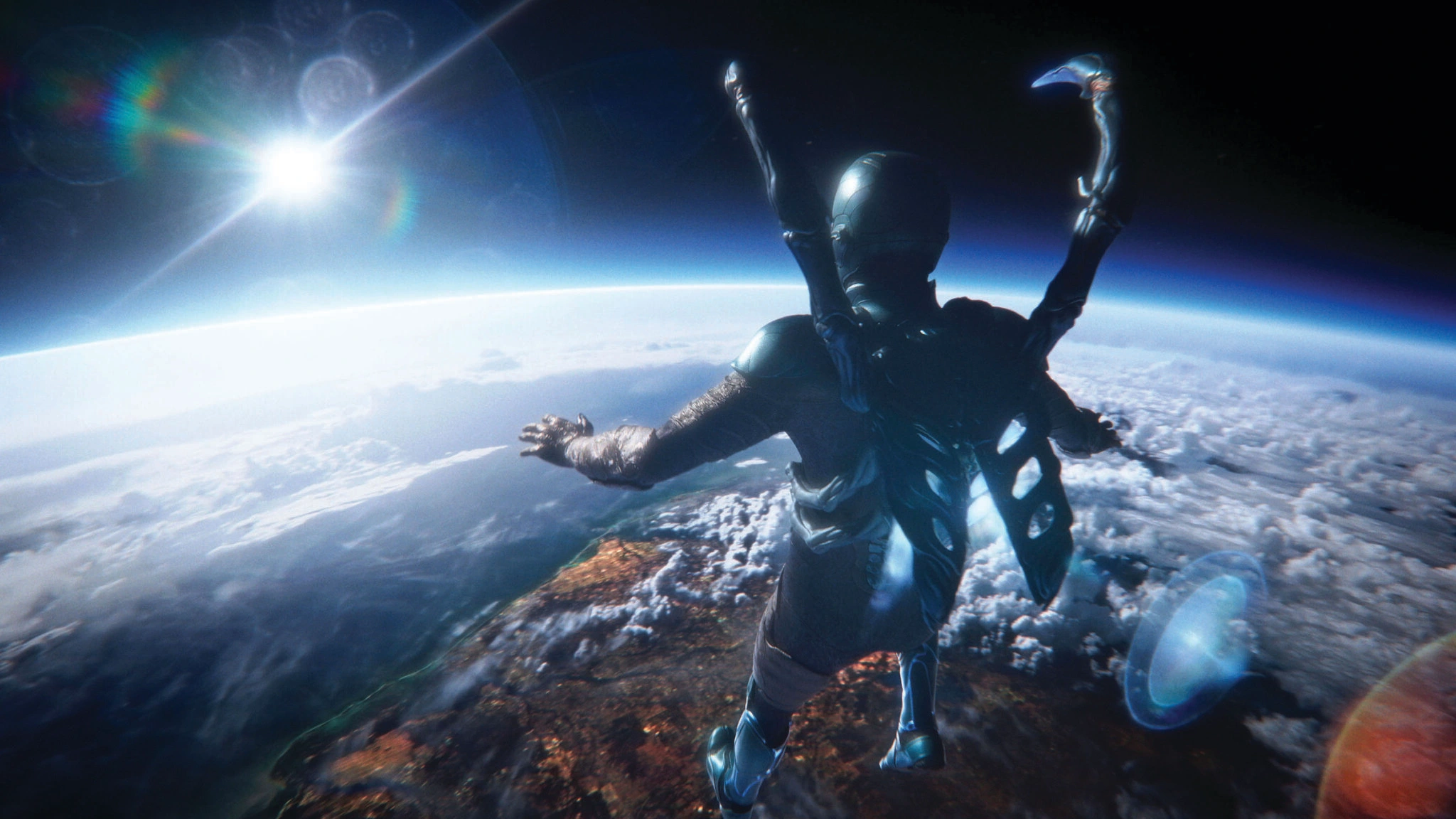
In April, Blue Beetle’s first trailer drew online debate because of a moment in which Lopez, as Uncle Rudy, declares that beloved DC icon Batman is a fascist. Some literalists believed that because Rudy holds that view of Batman, it must mean the Blue Beetle filmmakers do, too.
But it’s helpful to bear in mind that Uncle Rudy is cut from the same erratic cloth as Doc Brown in Back to the Future, and he’s a conspiracy theorist to boot.
“We always wanted to have fun with the way Rudy talks about other superheroes,” says Soto. “So to the people who got mad at it, give us a chance. We’re just trying to have fun with the characters that we love. And everybody in our movie loves Batman and Superman and Flash.
“And of course, we have criticisms about all of them, as we all should. But that doesn’t mean that we hate Batman. We love Batman.”
Maridueña’s joking response to the backlash: “F that!”
“Maybe Jaime and the audience don’t agree with Rudy, but you’re allowed to have your opinion. That’s okay,” Maridueña says. “If you felt some type of way about it, that was the point. So I think if you agree with it, if you don’t agree with it, it was placed there for a reason. And you know, all of the people who have their Batman shrines at home can keep them there and they don’t have to worry.”
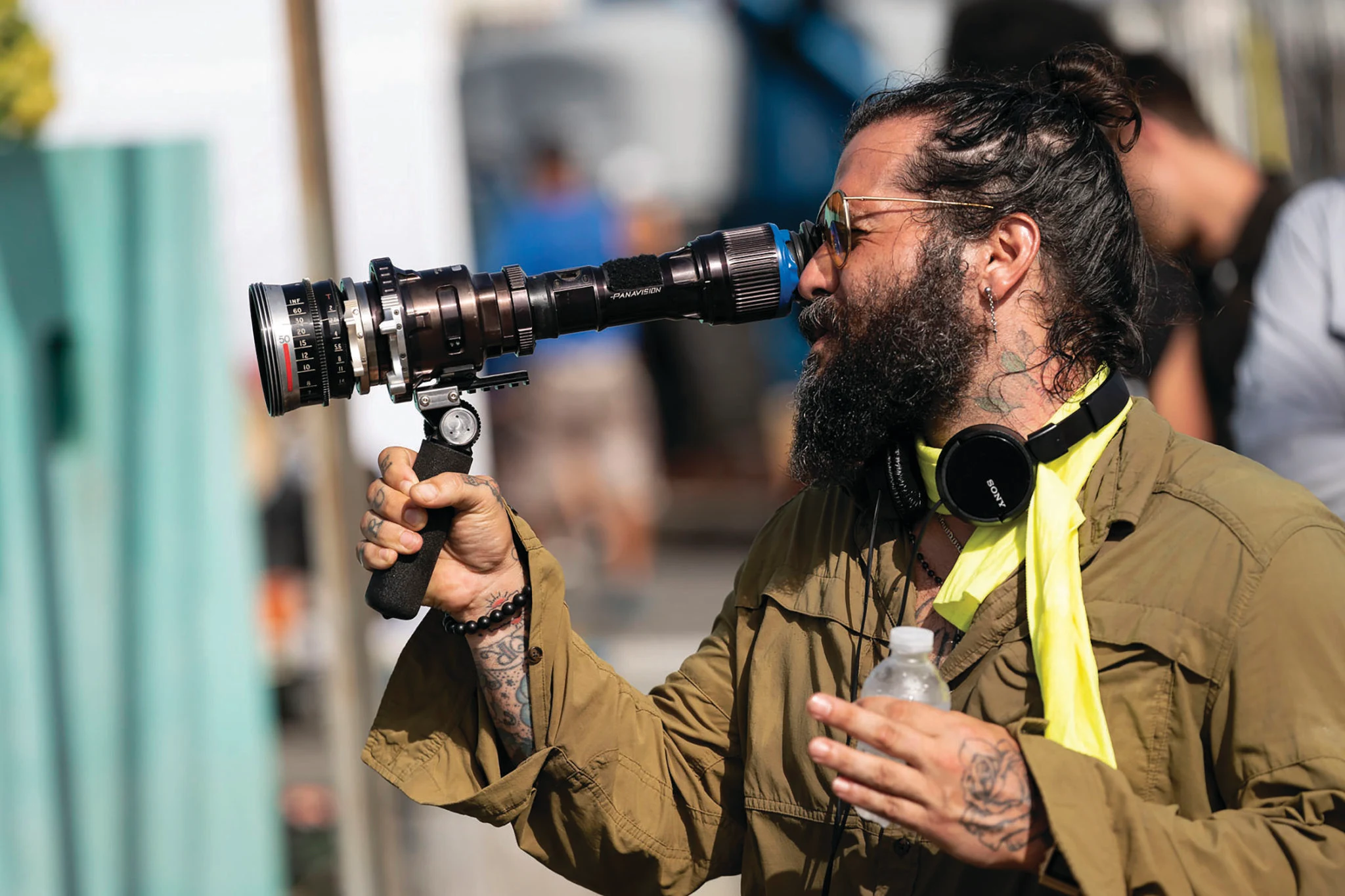
Blue Beetle director Ángel Manuel Soto on set. Photo by Hopper Stone/SMPSP.
How Blue Beetle Honors a Masterpiece of Mexican Cinema
Describing several aspects of Blue Beetle, Soto often repeats the same phrase: “Why not?” The approach has paid off, he says.
“I had no reason to bet on Xolo as much as I did, but I believed in him. And he gave me no reason not to, either,” Soto says. “To see him step up to the plate and become the superhero I didn’t know I needed is something I could have only dreamt of.”
Maridueña is at an age where he’s deciding what values from his childhood to carry into adulthood. Lone Lobos gives him the space to talk through those ideas.
He and Bertrand opened an episode of the podcast last year with a prayer and burned sage, which led me to ask about his faith.
“I practice a religion called Yoruba. It’s an Afro-Cuban religion that has roots in Christianity, but it’s mainly an African religion,” he says. “It’s something that I grew up with by proxy from my mother.”
He’s spent the last year making intentional choices.
“I love reading about science and metaphysics and spirituality. I think it’s something that’s super important to explore on your own,” he says. “I love learning about all religions and faiths and all different denominations.”
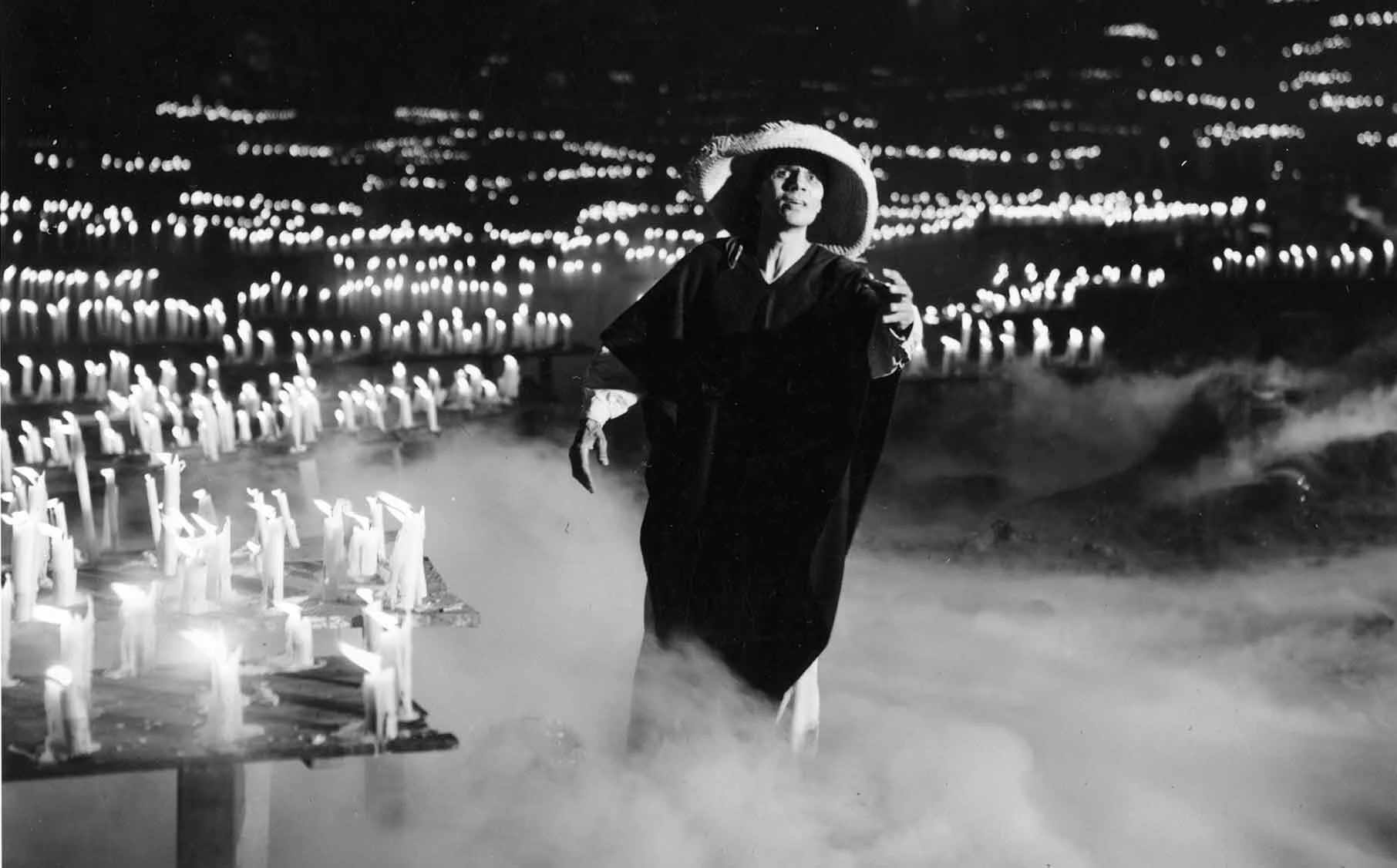
A still of Enrique Lucero in Macario, directed by Roberto Gavaldón.
Every religion offers respite, or a solution, to the reality of death, and Blue Beetle — spoiler ahead — explores an afterlife that’s astounding and moving. It is inspired in part by one of cinematographer Gabriel Figueroa’s shots in the 1960 film Macario — a film I deeply love.
To the uninitiated, Macario is considered one of the best Mexican films ever made. It screened at the Cannes Film Festival, and was nominated for Best Foreign Language Film at the 1961 Academy Awards. The story follows Macario, an angry woodcutter, who’s embittered by his lot in life. One night, October 31, he is visited by the Devil, God, and Death — who takes him on a journey to the afterlife.
There, Macario encounters Death’s cavern, filled with thousands of candles. The sight is breathtakingly designed, and Soto references it when Jaime visits his father Alberto in the afterlife.
“The magic realism of Macario stuck with me. When we were developing that scene, I was like, ‘Man, why don’t we pay homage to the movie that built us? Why don’t we pay homage to the movie that we can say is Latin cinema?’” says Soto. “Macario’s magic realism is beautiful and it’s smart like it is in Latin literature, and it’s ours.”
Soto worked with the VFX department and production designer to create an homage to Macario’s cascading candles, built from things in the Reyes home.
“There’s no logic to the imagination, except we construct things based on what we have experienced,” he says.
I didn’t expect a scene in Blue Beetle to move me, but this one did.
My dad died of congestive heart failure almost two years ago, and while my grief isn’t as heavy these days, every so often, I have thoughts like the one I woke up to on the day I saw Blue Beetle. On that Los Angeles morning, I thought: “What if I saw dad’s spirit right now in the living room?”
I walked into the empty living room, but he wasn’t there.
Imagine my surprise, then, to walk into a screening of a superhero film that not only references Macario, but evokes exactly the experience I had longed for, only hours earlier.
“No way. I’m getting goosebumps as you say that,” Soto tells me.
“That scene is close to my heart. I have not gone through the hardship that you went through, I can only imagine. And just imagining it, it’s heartbreaking for me,” he says. “But your reaction was exactly what we were trying to achieve.”
Maridueña calls the scene his favorite part of the movie.
“Damián Alcázar, the actor who plays my father, was so generous and wise and calm,” he says. “I remember thinking it felt ethereal for Jaime to see his father, but it was just his soul. It wasn’t his body.”
In that moment, Jaime makes a leap of faith.
“Jaime didn’t have a chance to say goodbye to his father,” he says. “I want people to understand that if you have your parents, just hug them, because you never know when it’s the last time.”
Soto didn’t have unlimited resources to make Blue Beetle, but his indie filmmaking experience helped him stretch a dollar, and ground the fantastic elements of the film in reality.
He points to his heart. “We gave everything to make something special and emotional that connects with audiences, and what you just shared is probably the best compliment I can get,” he says.
“Let’s tell stories that help us heal. I could care less about anything else,” Soto adds. “You just reinforced the reason why I want to do this.”
Blue Beetle is now in theaters, from Warner Bros. Pictures
Main image: Blue Beetle director Ángel Manuel Soto and star Xolo Maridueña on set. Photo by Hopper Stone/SMPSP. All photos courtesy of Warner Bros. Pictures/™ & © DC Comics.
Editor’s Note: This story was originally published July 5 and has been updated with Blue Beetle now in theaters.
Share:
Like this project
Posted Sep 21, 2023
Blue Beetle — a big-budget superhero movie that just may point the way forward for the whole DC Universe — owes its existence in part to the Sundance Film
Likes
0
Views
17


